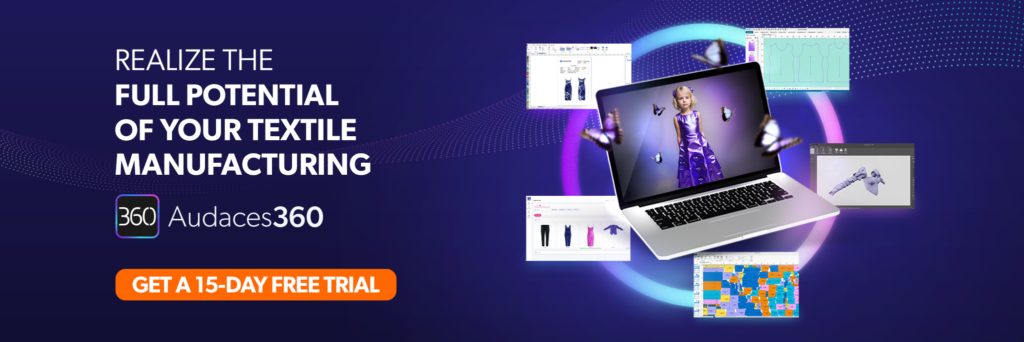Summary
- As technology advances, your company must keep up with the latest innovations.
- One key step is understanding what a CAD software is and its potential benefits for your business.
- Embrace the advantages of CAD tools for the fashion industry today. Try Audaces360 for free!
The fashion industry is undergoing a digital revolution. Industry 4.0 is transforming the way clothes are designed and produced.
Nowadays, there’s a lot of talk about Artificial Intelligence, cloud technologies, and even machines operating more independently.
In this context, the application of CAD software systems has had a significant impact, improving the work of designers and pattern makers.
Discover what CAD software is and how it revolutionizes design in our guide!
Sumário
How important is CAD software for the fashion industry?
CAD software is a game-changer for the fashion industry, as it empowers designers and manufacturers to work smarter, leading to a significant competitive advantage.
However, it is important to highlight it does not replace the human element in fashion design. Creativity and artistic vision are still essential!
The idea is to complement human work and gain agility, eliminating repetitive and time-consuming tasks.
Here are some improvements it can bring to your business’ workflow:
- Faster design iterations: CAD software allows for rapid exploration and testing of design ideas.
- Collaboration: teams can work together seamlessly and speed up collection launch time.
- Product innovation: CAD tools open doors for more complex and intricate designs.
- Reduced production costs: fewer errors and streamlined processes lead to cost savings.
- Improved quality control: greater accuracy ensures consistent quality in finished products.
- Streamlined workflow: digital tools automate repetitive tasks, saving designers and pattern makers significant time.
Learn more: How to use Artificial Intelligence design in your fashion creation

What is CAD software?
Ever wondered what a CAD software is? CAD stands for Computer-Aided Design software.
It is a powerful tool used in various industries, including fashion, architecture, engineering, manufacturing, automotive, aerospace, and construction.
CAD software allows users to create, edit, and manipulate designs digitally. It provides a digital environment similar to traditional drafting tools but with greater flexibility.
It can range from simple 2D drafting programs to complex 3D modeling applications, offering various tools and features to support different design tasks.
Fashion designers are enabled to create intricate patterns, sketches, and technical drawings with precise detail.
Unlike physical drawings, CAD designs can be easily modified and adjusted. This allows for faster iteration and exploration of different ideas.
Once you discover what is CAD software and how it can save time and effort, it becomes an indispensable tool!
This efficiency can lead to significant cost savings in the long run, making the return on investment quick.
Learn more: How does technology in fashion impact the textile industry?
How to choose the best solution for your needs?

Choosing the best CAD software for your needs can feel overwhelming with so many options available.
Here are some key factors to consider, ensuring you select the right solution:
1) Identify and define the problem
Before diving into the vast array of CAD software options, it is essential to clearly define the problem you’re trying to solve.
With an abundance of products available, it’s easy to get overwhelmed and make an impulsive decision.
Instead, take the time to identify the specific pain points or bottlenecks in your current processes.
By clearly defining the problem, you can narrow down your search to CAD software solutions that directly address your specific needs and avoid investing in features that won’t provide tangible benefits.
Learn more: How to choose the best fashion CAD for your business
2) Compare alternatives
Resist the urge to settle for the first option that comes your way. Instead, embark on a thorough research journey to compare and evaluate various CAD software alternatives.
Remember, implementing a CAD system requires an initial investment, so it is crucial to make an informed decision that maximizes your return on investment.
3) Evaluate user experience
The user experience plays a significant role in the overall adoption and effectiveness of CAD software. A well-designed and intuitive interface can significantly enhance productivity and reduce training time for employees.
Seek out online videos or tutorials showcasing the software’s interface and user experience. Observe how users navigate the software and perform common tasks.
4) Research integration capabilities
In today’s interconnected business landscape, seamless integration with existing software systems is important for streamlined operations and data exchange.
Evaluate how the CAD software integrates with your current tools, management platforms, and other business-critical software.
List all the software solutions currently used in your business processes, and research the CAD software’s ability to integrate with them.
Learn more: Explore the best fashion software options for your company
5) Define a realistic budget
While some CAD software solutions offer comprehensive features and advanced functionalities, their price tags may exceed your current budget constraints.
Don’t let this deter your digitalization efforts. Instead, establish a realistic budget that aligns with your financial capabilities and potential return on investment.
6) Test the software’s functionality
Before committing to a long-term contract with a CAD software vendor, take advantage of free trial periods or limited-time demos to thoroughly evaluate the software’s capabilities.
Allocate sufficient time to explore the software’s features, test its performance, and assess its suitability for your specific needs.
7) Seek feedback from your team
Extend the evaluation process beyond your own assessment and involve your team members who will be using the CAD software on a daily basis.
Their feedback is crucial in ensuring that the software aligns with their needs and preferences, fostering a smooth adoption process and maximizing productivity gains.
Learn more: Understand the importance of the textile industry and its evolution
Basic features of CAD software for greater efficiency

As you delve into the world of what is CAD software, take a look at the features to consider that contribute to greater efficiency and productivity.
Intuitive interface
A user-friendly interface is paramount for a seamless CAD experience. Ensure the software offers an intuitive layout, easy navigation, and accessible tools.
Consider how you will perform common tasks and whether the interface facilitates a smooth workflow.
Real-time visualization
Real-time visualization empowers you to see the impact of your design changes instantaneously.
This is particularly beneficial for collaborative projects, allowing team members to stay updated on modifications and maintain a consistent design direction.
3D presentations
3D modeling capabilities are particularly valuable in fashion design, enabling you to create and visualize garments in a realistic manner.
This allows for a better assessment of fit, drape, and overall aesthetics compared to 2D representations.
Learn more: Discover the functionality and benefits of 3D fabric to fashion
Preset models
Save valuable time and fast-track your creative process with preset models. Utilize them as a launchpad for innovation, not a limitation.
These pre-built templates provide a solid foundation for your designs, allowing you to focus on the unique details and customizations that set your creations apart.
Collaboration tools
Effective collaboration is essential for maximizing productivity in agile workflows.
Ensure the CAD software provides robust collaboration tools that enable seamless communication, file sharing, and joint editing among team members.
Simulation tools
Simulation tools, particularly in 3D modeling, allow fashion designers to evaluate the movement, fit, colors, and textures of garments as if they were real physical pieces.
This can significantly reduce the need for physical samples, saving costs and accelerating the design process.
Smart tools
Smart tools can enhance your processes by providing suggestions, identifying potential errors, and assisting in error correction.
These intelligent features can help you deliver high-quality designs, patterns, and markings with greater efficiency.
By incorporating these essential features into your CAD software selection process, you can empower your team to work smarter, faster, and more effectively, ultimately leading to improved design outcomes and business success.
Learn more: Learn how to incorporate digital patterns into your production
Meet Audaces360, the best multisolution in CAD software for fashion

Now that you understand what CAD software is, it is time to discover the ultimate suite of digital solutions for the fashion industry!
Audaces360 is a comprehensive solution that seamlessly integrates cutting-edge technologies to optimize production processes in the textile and fashion industry.
It caters to companies of all sizes and types, offering the flexibility to scale with your business needs.
Our tools were meticulously developed to address the specific challenges of the industry.
They are designed to streamline and accelerate your design and production processes, saving you valuable time and resources.
Audaces360 boasts a comprehensive range of functionalities, including digital pattern design, fabric marking, collection management, vector drawing, 3D creation, and fashion Artificial Intelligence to assist you along the way.
With our solutions, your goal of achieving increased efficiency, reduced waste, and a more agile and competitive production process becomes a reality.
Find out how Audaces360 drives digital transformation with our free e-book!
FAQ
CAD software is a game-changer for the fashion industry, as it empowers designers and manufacturers to work smarter, leading to a significant competitive advantage.
CAD stands for Computer-Aided Design software. It is a powerful tool used in various industries, including fashion, architecture, engineering, manufacturing, automotive, aerospace, and construction.
Identify and define the problem, compare alternatives, evacuate user experience, research integration capabilities, define a realistic budget, test the software’s functionality, and seek feedback from your team.










